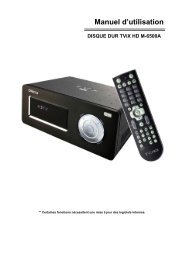MECABLITZ 50 AF-1 digital - Materiel.net
MECABLITZ 50 AF-1 digital - Materiel.net
MECABLITZ 50 AF-1 digital - Materiel.net
Create successful ePaper yourself
Turn your PDF publications into a flip-book with our unique Google optimized e-Paper software.
3 Preparing the flash unit for use<br />
3.1 Mounting the flash unit<br />
Mounting the flash unit on the camera<br />
☞ Turn off the camera and flash before mounting or removing.<br />
• Turn the knurled nut � towards the flash unit housing as far as it will go.<br />
The locking pin in the adapter shoe is now fully retracted into the case.<br />
• Slide the flash unit foot completely into the camera accessory shoe.<br />
• Turn the knurled nut � towards the camera housing as far as it will go, clamping<br />
the flash unit in place. If the camera does not have a locking hole, the<br />
spring-loaded locking pin retracts into the adapter case so as not to damage<br />
the surface.<br />
Removing the flash unit from the camera<br />
☞ Turn off the camera and flash before mounting or dismounting.<br />
• Turn the knurled nut � towards the flash unit housing as far as it will go.<br />
• Remove the flash unit from the camera’s accessory shoe.<br />
3.2 Power supply<br />
Suitable batteries/rechargeable batteries<br />
The flash unit can be operated with any of the following batteries:<br />
• 4 NiCad batteries 1.2V, type IEC KR6 (size AA). They permit very fast<br />
recycling times and are economical in use because they are rechargeable.<br />
• 4 nickel-metal-hydride batteries 1.2V, type IEC HR6 (size AA). They have a<br />
significantly higher capacity than NiCad batteries and are less harmful to the<br />
environment, since they have no cadmium.<br />
• 4 alkaline-manganese dry cell batteries 1.5V, type IEC LR6 (size AA).<br />
Maintenance-free power source for moderate power requirements.<br />
• 4 lithium batteries 1.5V, type IEC FR6 (size AA). Maintenance-free high-capacity<br />
power source with a low self-discharge rate.<br />
☞<br />
If your flash unit is not going to be used for an extended period of time,<br />
remove the batteries.<br />
Replacing batteries<br />
The batteries are flat or dead if the recycling time (elapsing from the triggering<br />
of a full-power flash, e.g. in the M mode, to the moment the flash ready indicator<br />
� lights up again) exceeds 60 seconds.<br />
• Turn off the flash unit at the main switch �.<br />
• Slide the battery compartment cover � forwards<br />
and fold open.<br />
• Insert the batteries lengthwise as indicated by the<br />
battery symbols provided. First, insert the batteries<br />
that face the display and then the others. Close the<br />
battery cover �.<br />
☞ When inserting batteries, ensure that the<br />
polarity is correct and matches the symbols in<br />
the battery compartment. Inserting the batteries<br />
in the wrong direction can destroy the flash<br />
unit!<br />
Always replace all batteries simultaneously, and<br />
make sure that batteries are the same brand and have the same<br />
capacity.<br />
Flat or dead batteries should not be disposed of with ordinary household<br />
waste. Help protect the environment, and dispose of flat/dead batteries<br />
at the appropriate collection points.<br />
91<br />
�





